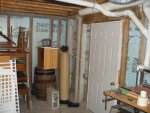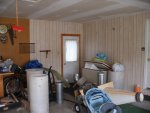I'm going off the assumption you're running around 900 cfm in your ducting, if you have 6" hole worth of openings on your duct at any point in time, which would be ideal for 6" duct.
A metal duct path 15' long is going to add around .2" water in 8", or .834" water in 6" With flex hose, I'm sure there's a huge variation depending on the type, but the rule of thumb I've always read is 3x ducting pressure drop for flex hose. So you're adding about .6" water static pressure with the 8" flex, which isn't bad, or 2.5" water with 6" flex which is pretty considerable for just connecting your filters.
Now the downside of the 8" is you're only moving around 2500 fpm which is well under the speeds to move dust that most dust colleciton/transport information recommend to move 100% of the dust. So you'll get some acculation. I know for my cyclone I haven't gotten a tablespoon of dust this year, so even if it was in the ducting I wouldn't notice. If you fill up your drum, you're going to be cleaning some ducting I would guess. Shouldn't be bad in normal operation.
You might be a little off 900 cfm, to really calculate it goes through an interative process, guess a flow rate, figure a pressure drop, check the curve to get the flow rate at that pressure, plug it back in etc until the assumed flow rate is close enough to the calculated flow rate. I think the results will be pretty close to the same though. I'd recommend reading through the pentz's stuff and/or the airhand.com design guide if you are interested in the exact impact on your system.
The 90's from
www.blastgateco.com or
www.oneida.com will probably work inside that pipe, google said it was 6-1/8" ID. I used the blastgate company's 90's slid inside spiral pipe and have had no problems with them. hand pland shavings, planer shavings, etc no troubles yet. They'll be a little loose so you'll have an edge inside, but the radius is a lot better.





